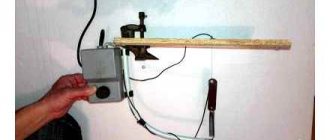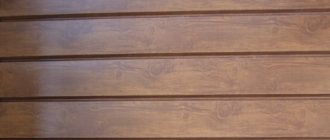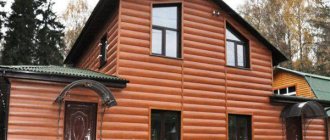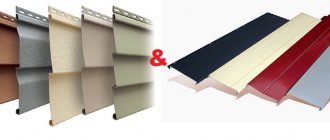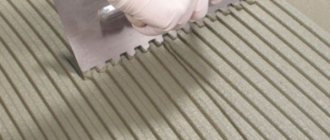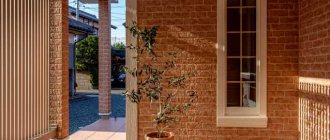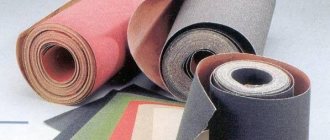When covering the façade of a building (front and basement) with siding panels, the material must be adjusted to the required dimensions and configurations. Using a special cutting tool, longitudinal and transverse cuts, figured cuts, and corner cuts are made. In order to perform quality fitting or cutting, you need to know how and with what to cut vinyl siding and metal siding . For such work, conventional hand and power tools are used. There are also universal devices on the construction market that are suitable for any type of siding panels.
Difficulties in cutting siding
Regardless of the material used, siding panels have a complex shaped profile. One of their longitudinal edges has a lock, and the second has a counterpart that snaps into a groove, and a perforated strip for attaching to the frame. The visible part of the panels is embossed and can consist of one, two or three waves of the same shape. And their thickness does not exceed 1.2 mm.
It is the convex relief, combined with the small thickness and the presence of hard multi-layer interlocking sections, that causes difficulties when choosing a tool for cutting siding. As practice shows, different devices are more convenient for each type of cut.
Shape and dimensions of standard vinyl siding Source montazh-saidinga.ru
Depending on the installation location, facing panels must be cut in the following ways:
- along the entire lamella to adjust its width to the cornice at the top of the wall;
- across the lamella to obtain the desired length;
- at an angle for facing the pediment and its design along the slopes;
- production of figured cuts for installation around openings and protruding elements of the facade.
In each of these cases, you need to choose what will be the most convenient, easiest and fastest way to cut the siding.
Extensions for decorative cladding have an even more complex shape. And if, when cutting panels, a neat edge is not very important, since it will hide in the grooves of the trim, then the appearance of the extensions should be impeccable.
External corner for siding Source domstyle.by
Selecting a cutting tool
During the installation process, in any case, you will have to cut the panels, and they will need to be cut across, lengthwise and even at an angle. Although many manufacturers provide instructions, problems still arise in some cases.
It is most advisable to address these issues specifically to companies that manufacture tools for working with siding. The various options are discussed below.
Electric saw
Many manufacturers offer to carry out work using a saw with fine teeth. However, making any cut is very difficult for her. In addition, looking at the assortment of the main leaders in production, you simply may not find such a device. A large number of experts agree on one thing: such a device is poorly suited for work.
Electric jigsaw
The tool can be used for cutting with certain reservations. After all, the vinyl panel is not hard enough to act as a support when making a cut.
Thus, you will have to face the problem when strong vibration of the plate occurs during the work. If for some reason it is necessary to perform these actions with a jigsaw, then it is better to choose the T101 blade.
Hacksaw for metal
Almost all vinyl siding manufacturers claim that this tool can make cuts in any weather. A hacksaw, of course, copes with its duties, but it takes a lot of time, which is not acceptable in modern life. However, she will be able to trim off additional elements quite quickly.
Metal scissors
Metal scissors can also be used to cut profiles for sheathing
It is this tool that installers most often use, since it does not require electricity, and the work is carried out quite quickly. However, it is not recommended to use scissors at sub-zero temperatures. Although many manufacturers advise starting from the top edge, where the fastening part is located, experts, in turn, believe that it is better to start the cut from the bottom.
angle grinder
Many vinyl panel manufacturers are extremely hostile to this device. They justify this by saying that the edges become brittle. However, in reality, the notorious “Bulgarian” has proven its worth. In a short period of time, cuts are made in any direction.
Conclusion! It is better to use a grinder or metal scissors as a cutting tool. They have shown themselves to be positive, and the work is progressing quite quickly.
Product manufacturing
To obtain this modern synthetic polymer, chlorine and oil are used as raw materials. Therefore, the resulting substance has low toxicity. That is, decomposition products can irritate the eyes and upper respiratory tract.
There are three production methods:
- The suspension method involves processing into products by rolling, injection molding, pressing or extrusion. At the same time, a relatively limited molecular weight distribution, low water absorption, excellent dielectric properties, thermal and ultraviolet resistance are observed.
- The emulsion method involves transformation into products using injection molding, pressing, extrusion, and also through pastes. In this case, the molecular weight distribution is much wider. Therefore, the product is characterized by a fairly high content of impurities and water absorption. The dielectric capacity, as well as color fastness, are slightly worse than in the first option.
- Mass technology can be used to produce various products by rolling, pressing or extrusion.
Note! Over time, the proportion of emulsion PVC is noticeably reduced. However, it has found its application in the manufacture of plastisols, which act as a protective coating for various materials.
Useful in construction
Of the total number of polymers, this product is most widely used in the construction industry. In European territory, the majority of polyvinyl chloride produced falls into this market segment. In the US these figures are even higher.
Such positive dynamics are primarily associated with numerous advantages:
- Fire safety, thanks to which additional protection of a wooden structure is achieved. The material is difficult to ignite and stops smoldering and burning immediately after the source of high temperature disappears.
- Dielectric capacity, allowing for a certain insulation in this regard.
- Long service life, making it possible to operate the product for about fifty years.
- Light weight, helping you get the job done to a great extent. In addition, transportation and processing of products is facilitated.
- The price is relatively low, providing enormous opportunities for people even with little income.
PVC finishing to transform the look
Note! The listed advantages, along with the ability to regulate properties within the required limits and the availability of raw materials, have a beneficial effect on increasing production.
Cutting Tools - Siding Performance Analysis
Experts recommend cutting plastic with the same tools that are used for cutting metal products. Therefore, we will deal with them in relation to each type of panel.
Knife
This tool is mentioned in all siding installation instructions. They say that before cutting vinyl or metal siding, you need to lay an even strip on it along the marked line and draw along it with pressure several times with the edge of a knife. And then break the panel along the formed groove.
Cutter knife with retractable blade Source iferr.it
See also: Catalog of companies that specialize in finishing materials and related work
These conditions can only be met on a flat plane, pressing the panel against a solid base. The curved relief of the siding will not allow you to make a neat cut across the panel; it will be especially difficult to cut through the material in the locking part. Therefore, the knife can only be used for longitudinal cuts and provided that the marking does not fall on the wave crest.
Hacksaw for metal
A hacksaw or saw with a very fine tooth is only suitable for cross cutting due to the short length of the working blade. This tool has too many shortcomings that do not allow it to be used for large volumes of work.
- Low speed and high labor intensity of cutting.
- Difficulty cutting panels lengthwise and at an angle.
- Impossibility of making curly cutouts.
- The flexible fabric moves to the side on curves and multi-layered areas.
- You can cut plastic siding only at above-zero temperatures.
Classic hacksaw for metal Source pimdatacdn.bahco.com
When choosing what to cut metal siding with, a hacksaw can be kept in mind, but all cuts should be hidden by extensions, since they do not have a very even and neat appearance.
Metal scissors
Like other hand tools, scissors should not be used when working with plastic in the cold season, as cutting with them may cause the material to crack. And this is not the only condition for achieving a good result. The instructions also recommend choosing scissors with a minimum thickness of cutting parts and not allowing them to completely close.
The last condition is easily met on smooth single-layer sections, but when cutting an S-shaped lock, you have to apply a lot of force, as a result of which the blades close by inertia, and a crack forms in front of them.
Advice! It is better to cut the siding with scissors across the panel from the bottom up, so that the most complex and thick locking part ends up at the end.
The quality of the tool is also of great importance - its sharpness, the absence of play between the cutting blades, and comfortable handles.
Disclaimer:
The information presented in the article is advisory in nature. Before cutting vinyl panels, consult with an expert where you purchased your siding.
One of the main advantages of vinyl siding is its fairly simple installation, compared to other finishing materials.
Of course, the price and quality of modern vinyl siding plays a key role for potential buyers. But the more forward-thinking among them will also appreciate the ability to install the panels themselves.
If desired, even a person who has no professional connection to the construction industry can handle the installation. If you want to save a considerable amount on installing panels, try researching this issue yourself.
The first question you will ask after purchasing siding will be: “How to cut vinyl siding?” Let's find out!
Briefly about the main thing
Cutting siding to size is complicated by the flexibility of the panels and their fractured relief, as well as the presence of complex bends in the locking part. Not all tools are equally good at cutting them, and some can only be used for one type of operation. For example, to make a recess for a window, it is most convenient to make transverse cuts with a jigsaw or grinder, and longitudinal cuts with a knife-cutter. And the most suitable tools for small fitting work are a renovator and a straight grinder. And yet, experts recognize the grinder as a universal tool.
Ratings 0
Basic installation diagram
Before cutting the siding and installing all the elements begins, preparatory work must be carried out and the supporting structure must be made. The coating can easily withstand sudden temperature changes and withstand strong winds if the installation of vinyl siding was carried out correctly.
Material calculation
- The length and height of one of the side walls are measured, after which these numbers are multiplied by each other. For example, 4×2.5=10 sq. m.
- Due to the fact that the opposite plane has exactly the same area, the resulting number is multiplied by two (10 × 2 = 20 sq. m).
- Next, the area of the other two walls is calculated. Again, the length is measured and multiplied by the height. For example, 6×2.5×2=30 sq.m.
- After this, the two results are summed up. Thus, the area of all the walls of the building is obtained (30 + 20 = 50 sq. m).
- It remains to find out the area of the two pediments. To do this, you will have to measure the height from the ridge to the base of the triangle, as well as the length of the base itself. It turns out: 5×6=30 sq. m.
- The indicators add up: 30+50=80 square meters.
Visual finishing planning
Note! To correctly calculate the area of the facing surface, you must add ten percent for waste to the resulting figure. As for the cornices, the number of soffits is calculated in approximately the same way.
Preparatory activities
Although this stage is quite simple, the quality of the facing surface largely depends on it. In preparation, you will have to stock up on the necessary tools, as well as eliminate unnecessary parts.
The whole process boils down to this:
- Removing interfering elements, which include platbands, grilles, canopies, drainpipes and the like.
- Tamping lagging planks or replacing them. Especially if the wooden parts are rotten.
- Eliminate plants around the perimeter of the building that could interfere with the assembly of the vinyl siding.
Lathing installation with thermal insulation
It is best to make a high-quality supporting structure with additional insulation for this type of façade finishing. As for the thermal insulation of facades, its installation is voluntary.
Well, lathing is recommended even with perfectly smooth walls, so that the inside is not deprived of ventilation.
It’s quite possible to build such a structure with your own hands:
Option with metal sheathing
- First you need to make a horizontal lathing from bars with a section of 50x40 or 50x50 mm. Its pitch is determined directly by the width of the thermal insulation material. In this case, a building level will not be needed, since leveling is not required at this stage.
- Having secured all the bars in this way, you can move on to insulation. Mineral wool slabs are inserted between wooden elements. Thermal insulation should not protrude too much.
- The insulation must be covered with a waterproof membrane, which will protect it from the harmful effects of moisture. Fixation is carried out to the transverse slats using brackets.
- The main sheathing is installed immediately after installing the waterproofing layer. A 25 mm thick edged board is perfect for this. First, two such planks are combined so that a right angle is formed.
- This product is installed using a building level on the side edge of the building. For leveling, as a rule, leftover lumber is used. All corners of the building are displayed in the same way.
- Next, a cord is pulled from one of them to the other in several places (most often at the bottom, in the center and at the bottom). The rest of the boards are installed on it. Horizontal lintels are made next to the openings.
Additional layer of thermal insulation for a brick wall
Note! If there is no need to insulate the building, then you can skip the first three points. That is, in this case, the sheathing should be attached directly to the walls of the house, and not to the transverse bars.
Assembling the cladding
Having reached this stage, you will have to choose how to cut the siding and other components. Additional accessories are needed to complete the look. Therefore, their main function is decoration.
Installing siding on vertical sheathing
Attention! During the work, no less than 1.5 mm should remain between fasteners and panels. Nails or screws should be located at a distance of approximately 30-40 mm.
When the question arises about how to cut metal siding, the answer suggests itself. Of course, you can use a hacksaw and metal scissors, as well as electrical devices designed for this material. Happy renovation!
How do you cut a block house?
Two panel strips are cut at 45°C. To perform the work, you should use special patterns. The cut is made with a hacksaw blade with fine teeth. Optimal cutting of block house
using a special hacksaw for parquet, then there are no burrs left on the panels.
Interesting materials:
What should the acidity of the soil be? Which vegetable likes acidic soil? What kind of sand should be added to the soil? What kind of soil is there in Russia the most? What nature is soil? What is the most fertile soil type? What is the top layer of soil? What layer of earth is called soil? What type of soil is most common? What type of soil predominates in the Russian Federation and why?
Molar knife
The simplest tool for cutting PVC. But for an unusual kitchen or shoemaker, all you need is a molar knife.
Its blade, while new, is very thin and sharp. And when it gets dull, the blade can be replaced instantly. By biting off a piece or inserting a new one. An ordinary knife is inconvenient and cannot be sharpened quickly. Also, it won't be as thin.
The molar knife is limited in its capabilities. You can only cut the panel lengthwise with it. Of course, you can try to make a cut across. But nothing good will come of this.
How to cut panels lengthwise? This is difficult to explain within the scope of this article. However, the basic principle can be described.
The blade extends a short distance of 3 mm.
From the back side of the panel we select the place where the cut will be made.
Then we cut out a strip, from edge to edge (we are talking about the internal edges of the panel). A cut is made near the rib, then another cut is made near the adjacent one. We make cuts along the entire length.
A strip of plastic falls out and a groove forms.
Then, on the same back side, you need to make a shallow incision near the desired rib. And break the body over it.
The molar knife has the advantages of being fast, quiet and simple. Its disadvantages are that the panels can only be cut lengthwise.
